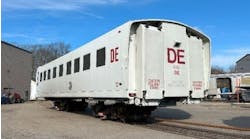To reduce fare evasion on the Orange Line, the Los Angeles County Metropolitan Transportation Authority (Metro) and the Los Angeles County Sheriff’s Department (LASD) Transit Services Bureau (TSB) have joined in a two-pronged effort to improve communication and enforce laws requiring riders to buy fare and use Tap cards when riding the Metro system.
New signs are being designed for all 18 Metro Orange Line stations directing riders to tap their Tap cards at validators to deduct appropriate fare. Also, Sheriff’s patrols have beefed up on the popular bus line that runs 18 miles between the North Hollywood Red Line subway station and Chatsworth and Woodland Hills. The Orange Line is a bus service that operates on an exclusive busway like a light rail line, therefore, there are no fare boxes on board and passengers must tap fare cards when entering each station. The Orange Line has about 30,000 weekday boardings.
“In recent enforcement audits we found that a majority of our passengers tap their cards and pay the fare when they enter stations, but an alarming number riders were not paying and a surprising number of people appear to be unclear about when and where to tap their fare cards,” said LASD Commander Michael Claus of the TSB. “Our new signs will direct passengers where to tap and we’ve added a new instructional video to Transit TV indicating that failure to tap may result in a citation and fine.”
Metro conducted three audits on the Orange Line in December and February. The first audit on Dec. 3, at the North Hollywood, Sherman Way and Van Nuys stations found that 22 percent of Orange Line riders evaded the fare by not having a valid Tap card or enough cash balance on the Tap card to ride the bus. In addition, 9 percent of riders with activated TAP cards and a valid pass did not tap before entering, which is considered misuse of the Tap card and not fare evasion. A second audit conducted Dec. 17 at the North Hollywood, Canoga and Reseda stations found 16 percent of riders evaded fares and 6 percent Tap misuse. A third audit on February 11, 2014 at the North Hollywood, Van Nuys and Canoga stations found 7 percent of riders evaded fares and 5 percent misuse of Tap.
“There is no excuse for breaking the law and trying to ride for free. The Metro Board has authorized many reduced fare programs for seniors, students, persons with disabilities and Medicare recipients,” said Metro CEO Art Leahy. “Metro fares are among the lowest in the United States. Our riders pay only 26 percent of the cost of operating our expanding service leading to a projected budget gap that, if left unaddressed, threatens the quality of service we provide.”
The base fare for Metro buses and Metro Rail is $1.50, but because of the wide availability of reduced fare programs, the average fare paid is 70 cents.
Tap is a universal fare system that includes 12 regional and municipal transit carriers in Los Angeles County. By the end of 2014, 26 agencies will be a part of Tap including Long Beach Transit and the Santa Monica Big Blue Bus, meaning there will be, for the first time, a seamless regional transit system in which riders can tap to enter and not have to count out change to transfer. In addition to accurate fare recovery, Tap also monitors flow of passengers allowing Metro to tailor service to demand.


